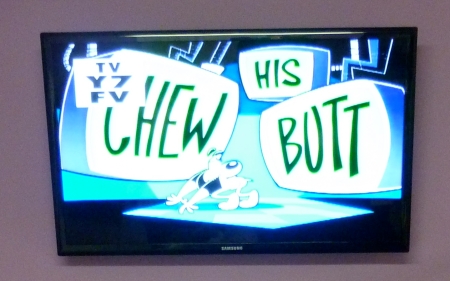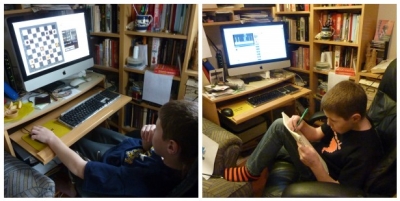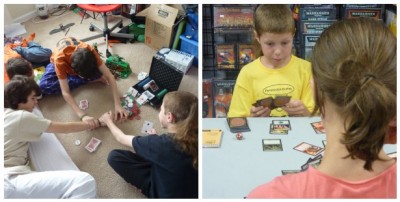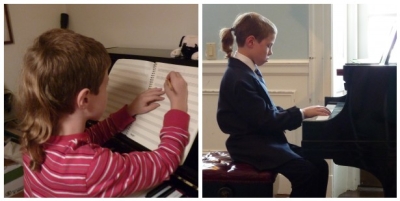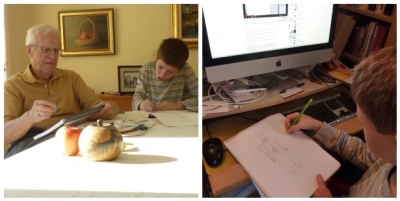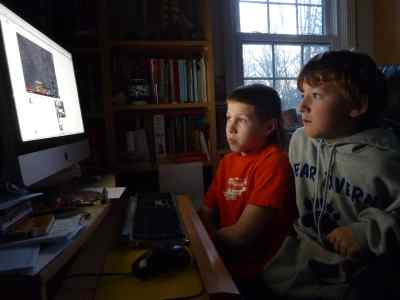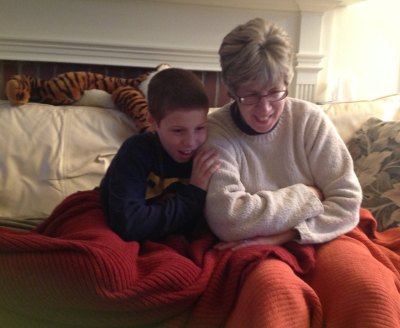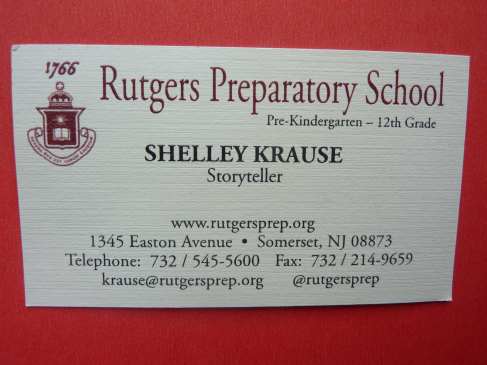Author Archives: Shelley Krause
Spring Break
Earlier this year our guy engaged in a school-based challenge: how tall a free-standing structure can you build using only one sheet of 8.5″ x 11″ paper and tape?
As Spring Break approached, he had a burst of inspiration. “Mommy! I think I have a better idea!”
So he spent several hours and multiple attempts testing his idea, explaining to me why triangles are strong and measuring his results against his previous best effort:
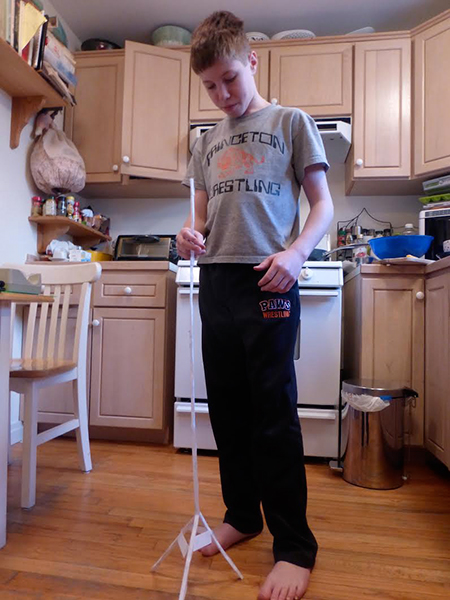
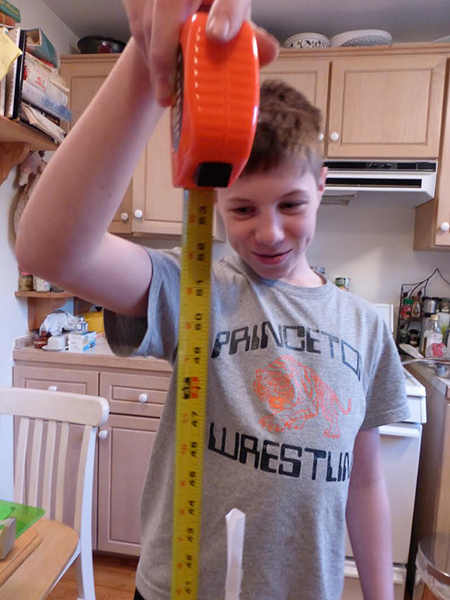
I’d also told him about a challenge that had been used in New Jersey’s Physics Olympics a while back, in which students are asked to see how far past the edge of a table they can get a penny to hang over, using only other pennies as support. This resulted in another multi-hour commitment:
Games For Change Festival 2013
Did we have a good time? Take a look at this and tell me what YOU think:
Miss T and I spent two days in NYC hobnobbing with folks who live at the intersection of games and learning… we had a GREAT time.
Here’s Miss T playing the extremely creepy Nevermind, which includes a biofeedback element as well as a faceless cat… she had to step away!
Day Two found Miss T checking out the amazing Blindside, a game which depends entirely on audio cues and motion-sensors for its game play. (Thus her closed eyes.) Later in the festival, Miss T had a lovely conversation with the co-creators of the game.
a Dorothy Parker quote, was entitled
“Sheep, Goats, and the Future of Learning” (link is to his slidedeck);
it was one of my favorites.
Junk Food, Brain Food, Soul Food
It’s a bright sunny day here in central New Jersey. Is your child sitting in front of a screen? And are you worried about it?
As parents, we have historically been conservative about our son’s screen time. He didn’t watch any television before he was two, and since our television lives in our basement, he has never really developed much of a taste for it. (“YouTube is funnier, anyway,” he says.) We don’t own a gaming system. But as he’s gotten older – he’s eleven now – our thinking has evolved. And we’ve begun to act on our belief that all screen time is not created equal.
Early on we felt an instinctive distinction between television and some kinds of computer time, just as my own parents made distinctions between public television and commercial television. When Mr. D. requested more TV time, we would ask, “Well, what is it you want to watch?” When he wanted time on the family desktop computer, we started asking, “What is it you want to do there?”
“What difference does it make?” he wanted to know.
Some television just feels like junk food, we said. You know those shows you didn’t plan to watch, but the show you wanted to watch turned out not to be on, and you’ve watched everything you had recorded, so you just end up sitting there, and you don’t even really like it that much, but it’s there, so you watch it?
“Oh yeah,” he said, excited by a sense of recognition, “and then you can’t even remember what you watched! Like Tuff Puppy!” (Here he made a disdainful face.)
Exactly, we said. But sometimes you’re watching because you meant to, with an intent to learn. Or you’re tuning in for a big game, or because a friend told you about the best show ever. And that feels different. And you do all KINDS of different things on the computer, right?
This “what are you thinking/planning” question has since become a staple of our family conversations around screentime. And Mr. D has started to make the case that sometimes, his screen time is not only not in the junk food category, it’s actually in the brain food category.
Here’s Mr. D playing chess against the computer, and transcribing a piano piece he wants to learn to play. Both brain food, right?
Once we started leaning towards thinking about screen time in these more specific terms, then we started talking about lots of things in terms of whether they represented a brain workout or not, and which kind of workout was more challenging.
Which of these card games represents more brain work? Three-handed poker or man-on-man tournament Magic the Gathering?
Which has got more of Mr. D’s neurons firing? Composing his own piece? Or playing a piece in a public recital?
Drawing from life with Grandpa? Or drawing from a YouTube video?
And what’s going on with these boys as they prepare to debate Minecraft strategies? Does the presence of a friend make a difference? We’ve had some great conversations.
The easiest thing is to lay down a time limit, and sometimes we still do that.
But he sees us sitting in front of our screens for hours at a time, and unless we’re intentionally transparent about what we’re doing, he has no idea what portion of that time is noodling around vs. paying bills vs. writing haiku. So the advantage of the more engaged, situational, and collaborative assessment of when screen time is “worth it,” is that someday (we hope), he’ll be a savvy and ethical consumer, sharer, and producer of media.
Junk food and brain food, check. But what about soul food?
That’s Netflix on the couch on a Friday night, people.
(Backstory: A few months back Lisa Nielsen shared her thoughts about the most recent American Academy of Pediatrics policy recommendation on screen time for children. She asked me what I thought, and her query, in addition to Robert Kim‘s offer to share this with his readers, got me to put down my book, pic up my camera, and dedicate a little screen time to sharing out our current thoughts and practice. Would love to hear others’ thoughts!)
The Eyes Have It
As I was trying to help a colleague with a project recently, we fell into a conversation about the challenges of discerning which skill sets it’s worth putting in the time to learn.
We each could think of examples of things that we’d spent time learning that ultimately became obsolete, as well as things we’d learned that surprised us by becoming suddenly relevant in an unexpected way, sometimes a long time after the initial learning.
One of the areas that has historically had the most dependable “payoff” ratio for me has been working with images. I realized fairly early on in blogging that I would sometimes want to use someone else’s image as a “springboard” for what I wanted to say, and I also wanted to be able to use other people’s images responsibly, so I taught myself about Creative Commons.
When I learned that giant image files could really impede a site’s load time, I invested some time in learning the basics of file compression. (Thank you, Preview!)
And even though Picnik is gone, I feel as though the time I spent working with images there wasn’t wasted… it helped me make sense of sites like Lunapic and PicMonkey. It also helped develop in me the expectation that an alternative to Picnik had to be out there somewhere… sometimes what I learn is less about the “howto” and more about confidence that there is a tool out there to help me do what I want to do, and that I’ll be able to find it.
So… as much as I depend on my ability to write my way out of trouble, I’m feeling as though my self-directed professional development efforts going forward – at least in the near future – are likely to focus just as much on the visuals. Because so far, that has always ended up feeling like a worthwhile investment of my time.
What are some things you’re hoping to learn in the year ahead, and why have you chosen those things?
What’s for Dinner?
(Photo by Claire Brownlow)
At home, when I ask my family what they would like to eat for dinner, I’m actually asking them to do some of the work. Some days, figuring out what to cook is maybe as much work as doing the actual cooking.
I’m starting to understand that the same is true of my communications work. Telling our stories is work, for sure. But figuring out which stories to tell is probably just as much work. When my colleague Kevin Merges was working on improving our campus sustainability efforts, he asked folks to send him “anything and everything” that seemed like it might be relevant, and I think I understand now where he was coming from with that. I need to get as many community members here as possible to get into the habit of sharing with me their ideas about the stories we could and should be telling.
Let’s Chat!
It is most definitely college application season here in the US.
Some things have changed a lot since my years as an Ivy League admissions officer (go, Quakers!), but some things seem not to have changed at all.
Let’s talk about how best to support students as they work on the one part of their applications they have total control over… at least theoretically.
* How do we talk with students about this process?
* Are there topics that are off-limits?
* How do you know if what you’re seeing represents the student’s best work?
* How can we provide feedback while still ensuring that the work remains the student’s?
* What advice have students found helpful?
* Who can and should students reach out to for support in this process? What can and should parents do (and not do)?
* With almost 500 college and universities members, the Common Application is increasingly US students’ first point of entry into this process. Is that good news? Bad news?
If you know of students, teachers, counselors, or parents who are “in the thick of this,” here’s your chance to listen, learn, and chime in! Thanks so much to Meenoo for this opportunity to help facilitate the #engchat conversation; I’m looking forward to it.
So fire up Tweetchat, keep an eye on the #engchat hashtag this coming Monday, October 15th, at 7:00pm EST, and jump on in!
Bonus points if you can help us get the word out… and please leave a comment if there’s a question you’d particularly like the group to address.
Shelley Krause
@butwait
Multi-Faceted
(Thanks to Bill Gracey of Flickr for use of this lovely, multi-faceted image.)
My new role within my school community is going to be multi-faceted.
I need to start with listening, and already in my first conversations with people outside the school’s community I can see that I’m going to need to to work on this. As someone who is rarely at a loss for words, I will need to find ways to make sure listening remains at the core of what I do. I will probably seek to find ways to continually reinforce the importance of that in my practice. It’s not just about telling the story — it’s about telling the right story — and there’s no way to do that consistently without listening.
Luckily, my “perch” in the Upper School puts me within easy range of most of that office’s walk-in traffic. Last week, as families were working through their back-to-school checklists, I heard a distinct undercurrent of anxiety.
Beginnings can be scary. Change is usually a challenge. The beginning of the school year brings our families and students new teachers, new routines, new classes, and, for 123 Rutgers Prep students this year, an entirely new SCHOOL! It’s all exciting, but it can definitely also generate anxiety. I have an idea for a media project that might help address that. I’m superstitious, so I don’t want to say more than that just now. But stay tuned.
So that’s the community-facing facet of my new work. Then there’s the work that is more directly related to my peers. On any given day, there are multiple people on this campus who represent our school to stakeholders and other interested parties. Together, we command a deep and impressive understanding of what makes this place “tick.” But we’re busy, and scattered across campus, and we can’t always connect with each other quickly. I want to work to somehow help enable our “hive mind” capabilities. A wiki, maybe? A Google Docs-based Brag Book? We’ll see. That’s the team facet.
And finally there’s me, standing at the bottom of a learning curve and looking straight up. For while there are ways in which I am especially well-suited to this work, there are some obvious, near-painful gaps. I need to get out of the Upper School. There are teachers here who I’ve never really had a conversation with and whose grade level I might be unsure of if I saw them in the Dining Commons. So that’s my very own personal facet of the work ahead. In the words of the Music Man’s immortal Harold Hill, “You gotta know the territory!”
Storyteller
Once upon a time, in a land not so far from ours, there lived a storyteller. She came from a small village, and loved to make the people there laugh. She also loved to learn, and so found herself drawn to schools. After attending school herself for many years, she moved on to helping several colleges tell their stories to would-be students. When she eventually had a child of her own, she moved over to a high school to work more closely with students. There she happily spent her days seeking out, listening to, and helping students discover and share their stories. Her students were young adults who were in the midst of discerning which stories they were meant to live, so both the stories and the learning were rich with promise.
One day, when she had been doing this counseling work for quite some time, a leader in her learning community asked her a thought-stirring question. “What would it take,” he began, “for you to find and tell stories on behalf of our entire community, in addition to doing that on behalf of individual learners?”
The storyteller was surprised by how quickly she was able to respond – she was something of a slow thinker, and friends had learned that her contributions would often come near the end of a conversation. “What would it take? I would have to work with fewer individual students!” she answered with a broad yet rueful grin, for she knew as well as he did that their school’s classes were growing in size. “Fewer students” was not going to happen any time soon.
But then, as sometimes happens in stories and in life, a way opened. A colleague who sought new challenges and greater opportunities for student connection was intrigued by the possibilities that taking on some students as counselees might represent for him. The idea of adding an already-trusted colleague to the counseling team made a shift in the storyteller’s responsibilities seem a less daunting prospect.
The more the storyteller thought about it, the more she began to feel that this new path was one that she was meant to take. The tools available for story sharing had developed so dramatically since she had first begun this work… wouldn’t it be wonderful to see what could be done now? And weren’t there untold stories within her current school community that she would be pleased to share, and that others might be delighted to discover?
So when the chance came, unbidden and still somewhat in need of shaping, she smiled again… and took it.
Feeling the Shift
 |
| 4×6 index cards + tape + locker wall = schedule! |
Edcamps have changed how I think about conferences. On March 2nd, after attending (and presenting at) the NAIS Annual Conference in Seattle, I tacked on an additional day to my trip so that I could attend edcampIS. (The “IS” suffix stood for “Independent Schools.”)
Edcamps are as close to spontaneously-generated professional development as you can get; the session schedule depends on who shows up and what they’re thinking/ wondering about. Sarah Thomas (@teach2connect on Twitter) and I both thought that a session on Twitter for Newbies might make a good addition to the edcampIS schedule, so when she saw my Tweet on the subject, Sarah sought me out and asked if I might like to team up. “Would love to!” I said, and in fact I had been thinking about how much better a co-facilitated session would be, so… we went from following each other to meeting each other to running a session together in the space of less than an hour! (Big ups to Rachel Wente-Chaney, whose awesome Flickr photoset from the day provided the photos associated with this post.)
 |
| Sarah and I delightedly planning our session
So here’s the shift I’m feeling. The prospect of a full day’s worth of “sit and get”-style learning feels different (and less appealing) to me now that I have deeper understanding of the range of possibilities. (Clay Shirky predicted this years ago with his story of a four year old poking around behind a newly unboxed television. When the little girl was asked by her parents what she was doing, she explained, “Looking for the mouse.” She had an instinctive sense that any screen that shipped without an input device must be missing something. See Clay Shirky’s TED talk on Cognitive Surplus for more context on this.) With the edcamp movement growing by leaps and bounds, more and more of us are becoming “spoiled.” If my experience is any guide, exchanges that have historically been built solely around passive consumption are going to need to move towards offering at least some opportunities for meaningful exchange, contribution, or creation.
Lately, I’ve started to feel this shift not just in my orientation towards learning, but in my orientation towards “stuff.” I’ve been a somewhat reluctant participant in our consumption-oriented culture for as long as I can remember, but lately I’ve noticed being pulled towards buying things in a way that feels new to me. Except they’re not really things, so much as they are experiences, or at least things with some kind of social element. I’ve increased the size of my loan portfolio on Kiva. I’ve chipped in to support several projects on Kickstarter. In Lemonade Detroit and Gayby Baby, I’ve pitched in to support two different independent films on topics that are meaningful to me. And I’ve felt myself leaning towards looking for material goods on Etsy, where it seems more likely that the transaction will include at least some small element of human connection. Don’t get me wrong. I’m still a big ol’ fan of the occasional Lands End shop-a-thon, and I was disappointed to miss out on my near-annual pilgrimage to the outlets in Flemington this spring. But I can feel my emotional engagement moving in a different direction.
Thinking about all this has suddenly brought to mind another true-life story that features a four year old… mine, this time. I was at home serving as Mr. D’s primary caregiver for the first three years of his life, so we spent a lot of time together. He was my little shadow… when I was in the living room, he was in the living room. If I was in the kitchen, he was in the kitchen. As I worked on meals, I would take out a few pots and let him bang happily about in what felt like a time-honored tradition. Then, as he approached his fourth birthday, he figured something out. The kitchen work I was doing resulted in FOOD. Why didn’t his? In what felt like the blink of an eye, our little man went from being perfectly happy taking lids off and putting them back on again to no longer deigning to do so. He wanted to help, and he was suddenly quite able to draw the distinction between “make work” and the real thing. I gave him lessons in how to safely wield a knife, and he never looked back. It’s not a perfect analogy. Traditional conferences still have their uses. (I felt like I got a lot out of the NAIS annual conference, actually.) Retail shopping will continue to suck up a good-sized chunk of our take-home pay for the foreseeable future. And yet. I do feel a shift. Away from one-to-many “solutions” based on a presumption of consumption, and towards more human-shaped interactions that allow for or even require creativity, contribution, dialogue, sharing. I am less content than I was with the way things are… which more and more has begun to feel… like the way things were. (Thanks for reading!
Would love to hear if you’re
experiencing any shifts like this…)
|
NAIS in Seattle
From knowing…to doing (project-based learning)
From teacher-centered… to student-centered
From the individual… to the team
From the consumption of info… to the construction of meaning
From schools… to networks (online peers & experts)
From single sourcing… to crowd sourcing
Pat’s tone, while generally positive, was tinged with concern; I got the sense that he feels schools which are unable to make these shifts run the risk of contracting a terminal case of irrelevancy.
Throughout the conference, I was struck by the implied tension between those who “get it” already, and those who are only just beginning to “get it.” In Chris Bigenho‘s great session with Jason Kern & Larry Kahn about running a TEDx Youth Day at a school, some of those drawn to the conversation seemed to despair of ever getting “the powers that be” at their schools to agree to such an energy-hungry commitment, in part because of the already existing constraints on student and faculty time.












